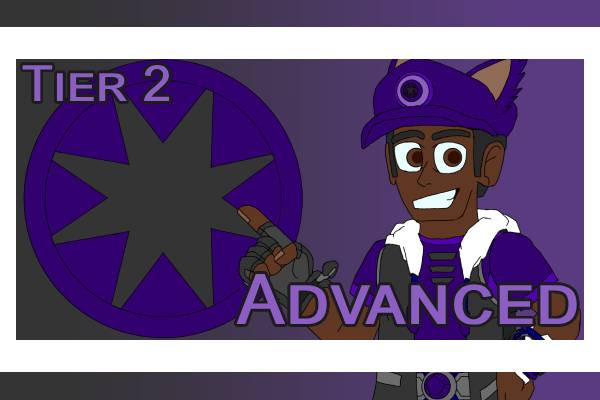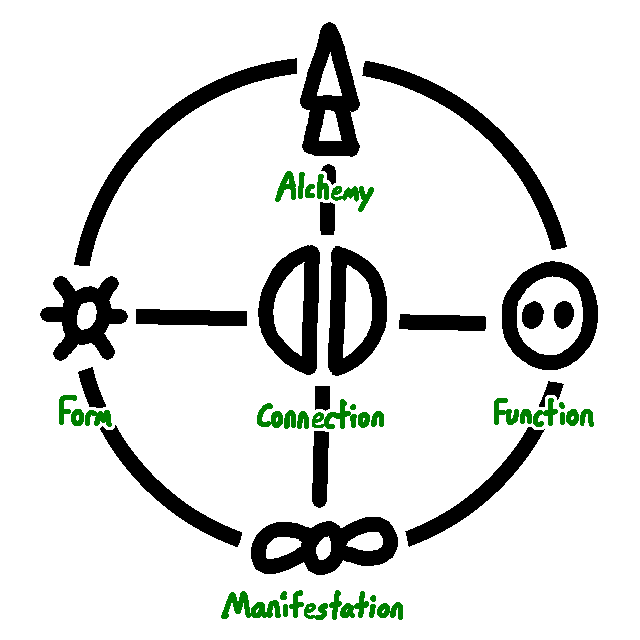HOME | DD
 Notshurly — Alchemy Elemental Symbols
by-sa
Notshurly — Alchemy Elemental Symbols
by-sa

Published: 2009-12-19 02:29:58 +0000 UTC; Views: 48908; Favourites: 241; Downloads: 2525
Redirect to original
Description
Another part of the alchemy lessons I am giving on deviant art. This shows you all the beautiful symbols I have modified. These aren't the same as the symbols many of you may have come to love, but I find them easy to understand and so much better in a transmutation circle.Related content
Comments: 58

According to Serif... and when I googled the word, you misspelled Berylium. It needs another L. Beryllium.
👍: 0 ⏩: 1

Shit happens, bro. Look into to icons eyes and you'll see how much I care....
Though I probably will go back and fix it.
👍: 0 ⏩: 1

I never implied you would care. I just wanted to state it. Maybe if you made another one, you could add the spelling correction to the to-do list.
👍: 0 ⏩: 0

epic!
Do you know any sites that contains the entire periodic table in this format? or almost all of it? Or maybe if you yourself have it could I please view it...
~if anybody else knows anything I'd be ever so grateful...it's for my course work you see ~
👍: 0 ⏩: 5

I'll do a tutorial on that soon. And no, I know of no such list.
👍: 0 ⏩: 0

This is my 4'th reply and in case you didn't know, the order you need to read this is bottom to top. But the actual reason for replying is that I realized I'm retarded... sort of.
First off, it took me a long time to write everything I did... and I may have given the info to the wrong guy. The info is still useful... But the guy below your comment MIGHT have been who I wanted to reply to. Not really sure so I'll just talk to the other guy and let him know about everything I said as well... I kinda hate making an ass of myself.
Second. Everything I wrote was pretty much pointless. I mean, it deconstructs normal matter and reconstructs it into Fluorine which does have it's use. But... on the bottom of this image it says if you use your own symbols, then you need instructional text to say what the symbol is for. It's not like you can't get Fluorine. But if you wanted to grab it out of the air or ground or something then you'd need an array to get that resource for free. But it would be easier to just make a symbol for it. But that depends on what you're doing.
👍: 0 ⏩: 0

Here's me figuring things out.
Before we begin:
Here's the thing. You have about 2 ways to get the matter for Fluorine. I'll make it simple. It's better to start out with the exact matter you need and can make calculations. Like imagine if you started out with matter who's number of protons, neutrons and electrons that you knew. You could calculate how much X element you needed to make Fluorine with enough left over to make Y element (so that you don't waste materials by flinging it into the air. You could turn it into something useful instead). The alternative (I'd rather not use) is using an array that grabs neutrons, protons and electrons from the air and combines them into Fluorine. This would be fine except I can't guarantee that it would work since I have no idea if it's true. It's better off if you can calculate things.
Let's Begin:
So I'm going to be using a couple sources. The wiki page on Iron and Fluorine (as I mentioned before) and this yahoo answers page "answers.yahoo.com/question/ind… ". I'm not gonna bother mentioning which source I get the info from. I named them, the things I say are from at least one of them. *clears throat* Iron is the fourth most abundant element in the Earth's crust so it's not rare. We can transmute it into Fluorine. Iron is made up of 28 protons, 28 electrons and anywhere from 20 to 57 neutrons. Iron is stable with 30, 31 and 32 neutrons. So that narrows it down. The amount of neutrons doesn't matter for Fluorine since it doesn't have any neutrons. So let's just go with 32 for now since it does matter for the excess. Fluorine has 9 protons and 9 electrons with no neutrons. So to give a simple example. Let's start with a round number of Iron (and add more if I need to feed my OCD)... say... 10. That's 280 protons, 280 electrons and 320 neutrons. Let's create as much Fluorine as we can with 10 Iron atoms.
After doing some quick math then doing the VERY long math to double check, with 280 protons (also electrons), you can make 31 Fluorine atoms with the extra of one electron and proton. I'll organize it nicely.
10 Iron atoms:
Protons: 280
Electrons: 280
Neutrons: 320
Into-
31 Fluorine atoms:
Protons: 279
Electrons: 279
Neutrons: 0
Extra Protons: 1
Extra Electrons: 1
Extra Neutrons: 320
Bad example...ish... But you have excess matter in this case. Perhaps you could reduce the number of Protons and Electrons in Fluorine and just try your best to use math to have no extra Protons, Electrons and Neutrons laying around. In this example, that number of Fluorine is useless but also the number of excess particles is too low to care. But when you're dealing with large numbers of atoms, it makes a bigger deal. Anyway, I think you get the point. I can't really walk you through every step (as there's a tiny bit more to do) but I think I explained it well enough for you to get the point.
👍: 0 ⏩: 0

Here's me actually helping you.
If it's really hard to follow or it's too cluttered, let me know. Because I really want to make this more readable IF it's a problem.
I looked it up. I expected Fluorine to be a chemical made up of other atoms (like water is Oxygen and Hydrogen) but I didn't see anything to indicate that thus far. So the solution is more complicated. But I found out that it is made of 9 Protons and 9 Electrons (it says nothing about Neutrons so let's go with 0). This is important because now all you need is an array that changes the very make up of atoms. All you need is an array that takes any ordinary matter, removes, adds or leaves alone; Protons, Neutrons and Electrons.
Let's say for example, you have matter with 10 Protons, 5 Neutrons and 15 Electrons. I didn't feel like looking up actual matter and finding the numbers. So I made up with random numbers. I don't care if that matter doesn't exist or is radioactive or whatever. Let's say it's a common element and you can get lots of it easily. Like, as common as water. Okay not THAT common but you get my point.
Make an array that takes the common matter above and then removes 1 Proton, 6 electrons and 5 neutrons. Then moves it into a glass case while taking those left over particles and creating extra matter instead of just ejecting matter into the air which will take up too much space to list why it's better to not throw it away. It's kind of like Fuel Cells. They do some chemical shit and the byproduct is electricity and H20 or H202 (not sure which). Fluorine is a gas at room temperature so you need to transmute matter into Fluorine then move it into a case.
To summarize. Make an array that turns X matter into Fluorine, moves the Fluorine gas into a case for safety, then takes the left over matter and makes something useful out of it instead of wasting it.
Note: You can't use any matter. You need to make an array for ONE specific kind of matter. You can't just design a transmutation array and take anything. You can transmute any matter into Fluorine (provided you have the requirements, equivalent exchange and all). But you need the array for it. What I said was misleading so what I mean is, you can transmute anything into Fluorine. But you need an array for that matter. It's a LOT easier if you think about what you're doing. I'll post it in another comment so you can read this now while I work things out.
👍: 0 ⏩: 0

I have a way to help you out. But I wanted to let you know before I got started. Since it would take me several minutes or more to do. So yeah. Ima help you out.
👍: 0 ⏩: 1

I'm so so sorry. I haven't been on deviant art in a while due to health issues. accept my apologies, please
thank you so very much for your help!! 
👍: 0 ⏩: 1

That's okay. You're welcome.
👍: 0 ⏩: 0

epic!
would you happen to know of a site that contains the entire periodic table? Or if you've done it could I view it please?
~if anyone else has this knowledge also, please help, I need this for course work ~
👍: 0 ⏩: 0

Do you have one for Fluorine? It's the only human transmutation ingredient left on my list.(:
👍: 0 ⏩: 2

Perhaps. Or you could make one. I'll do a tutorial on that soon.
👍: 0 ⏩: 0

Last night I spent hours doing math and thinking about Alchemy... only to realize I may have given my comments to the wrong guy.
I explained to most likely the wrong guy (as I'm not 100% sure who it was I meant to give the info to. Last night that is. I'm like 60 to 70 percent sure it was you though) about how he could get Fluorine. Read my comments to Souless-Broken-Blade to get the specific detail. Because this is gonna be short. I explained that if he wanted Fluorine he could get his own Fluorine by transmuting normal matter into it. Fluorine is probably not that abundant and I'll get back to that after this. I realized a few minutes ago that you could just make a symbol for Fluorine (as long as you explain what the symbol is and what it does in instructional text in the array) and it would be a bit simpler to use a symbol if you're using Fluorine in a Human array. BUT I also realized that it doesn't solve the problem. The idea I got when creating my comments was that someone needed Fluorine and didn't have a way to get it. They needed a symbol for an array to get Fluorine. Since there wasn't one, I came up with how to make Fluorine. If you're transmuting people, then you need a symbol for Fluorine. No problem. Except if you don't actually have Fluorine, then you need to create it. The simple explanation of how to make it was that you get a lot of one element. Something really common. Then you take apart the protons, electrons and neutrons. Then you combine them to make Fluorine (9 Protons, 9 electrons and 0 neutrons). If you have left over matter, take that excess and transmute it into something else instead of flinging disassembled matter into the air that will never be used again.
So both things include arrays. If your problem was that you need a symbol for Fluorine so you could create a human... make your own symbol. If your problem was that you needed a symbol for Fluorine so that you could make an array to gather Fluorine from your surroundings (which is what I thought while writing my comments to Souless which were for you) so that you'd have Fluorine for human transmutation... then I explained a way to get Fluorine. Just read my long comments to Souless. Read them bottom to top. You could make a symbol for Fluorine but odds are, there isn't much Fluorine to gather from your surroundings (at least as far as I know, it isn't as common as Earth that you can manipulate normally and gather lots of in small spaces).
I think I said and explained what I needed to. My intention was that this wouldn't be long... but it was.
👍: 0 ⏩: 0

Why is the image HUGE but the symbols are low quality and rough?
👍: 0 ⏩: 1

It was originally done in paint.exe
But it drives fine the point, and that's what matters.
👍: 0 ⏩: 1

Sure. But I was just curious. I'm kind of an OCD graphics whore. When I see something crappy that could easily be made so much better, I get antsy.
👍: 0 ⏩: 0

Being a lover of the periodic table... Why didn't you arrange this in the same order?... just curious is all ^-^
👍: 0 ⏩: 1

I didn't have enough symbols or care. It's just a basic display and I left it at that.
👍: 0 ⏩: 0

So, would Salt be an open circumpunct (Chlorine) with a horizontal line (Sodium) in it?
👍: 0 ⏩: 1

I usually just show them compounded, but there are symbols out there specifically meaning table salt.
👍: 0 ⏩: 0

As well with the diffrent symbols you have, each alchemest's symboles differd slightly from an other like Sir Isaac Newton's symboles were diffrent from John Dalton's and that was to keep there work encoded so someone else could not take it.
👍: 0 ⏩: 0

Yeah, cesium's there... why? Cesium is the most violently reactive metal known (ignites in air, explodes in water), so why would alchemists be using its symbol in transmutations?
I recognize a few of these symbols... nine of them were used by John Dalton himself, albeit slightly rearranged (sodium's had 2 vertical lines, potassium's had 3, calcium's was the one you're using for chlorine, yttrium's was the one you're using for calcium).
I'm still saying this is uber awesome!
👍: 0 ⏩: 1

I have cesium for that very reason. It can be purified in the array, then the reaction can be instantly halted and the cesium can do what it does best!
👍: 0 ⏩: 1

Cesium bomb... very nice and very destructive, as the products are the hypercorrosive cesium hydroxide and the equally flammable hydrogen gas.
👍: 0 ⏩: 0

The nitrogen symbol and the sodium symbol look similar, so would you have to distinguish them with text? Or could you just use them on their own with no ill effects?
👍: 0 ⏩: 1

If they need to be distingquished, then do so by text. But if only one is being used in the array, then, so long as the alchemist knows what symbol it is, everything is cool.
👍: 0 ⏩: 0

i could be mistaken but isn't the symbol you used for hydrogen already used to represent gold?
👍: 0 ⏩: 1

Quite right. It's some pretty poor symbology, but we go with it. I usually distinguish which is which in text, or I use a different symbol for gold.
👍: 0 ⏩: 0

aztec numbers were the ones to represent elements in the old days
👍: 0 ⏩: 0

you do know that while litle is truly known now the aztec number system was what alchmist aregenatly used
👍: 0 ⏩: 0

Wait...you said you modified them? Even though they ARE pretty, how do you know they're the write on?
👍: 0 ⏩: 1

I don't, but I did it because many of the symbols did not exist before as certain elements were not yet discovered.
👍: 0 ⏩: 0

hmmmm some of this never came to be in the past did they?
👍: 0 ⏩: 1

Nope. Some of these are rather original. However, I came across a better idea. I shall use the Chemical symbols now!! Hooray!!!
👍: 0 ⏩: 2

A question, if I may... What do you mean by 'chemical symbols'?
Also, I look forward to your updated chart of elements... but I also look forward to symbols for heat, photons/light, and actions such as smelting, or evaporating.
👍: 0 ⏩: 1

The symbols we use in chemistry. C, O, H, Ag, Au, Na, K, etc.
👍: 0 ⏩: 1

Ah, that does make sense.
Again, thank you
👍: 0 ⏩: 0

xD well that's...a lot more useful in today's world if less in design it makes up for practicality and understanding.
👍: 0 ⏩: 0

Were these, by any chance, based on the early elemental symbols from way back when? I don't mean the alchemical ones, I mean the ones that were used between the establishment of chemistry as a science and the invention of the alphabetical elemental symbols. I'm pretty sure I recognize the general design.
👍: 0 ⏩: 0

Were these, by any chance, based on the early elemental symbols from way back when? I don't mean the alchemical ones, I mean the ones that were used between the establishment of chemistry as a science and the invention of the alphabetical elemental symbols. I'm pretty sure I recognize the general design.
👍: 0 ⏩: 1

Some of them were, yes. Dalton (thats the only way I know him by) was a scientist who used simple symbols to represent smaller elements, then combined them to make bigger elements and molecules. I will upload a chart of his work, as it is hard to explain.
👍: 0 ⏩: 1

Dalton! That's the guy I was thinking of. I found his stuff when I was doing research on how to represent elements outside of those covered by alchemical symbols.
👍: 0 ⏩: 1

He had it going for him. I prefer his alchemical symbols because they are symbols contained by circles, and thats very handy in array making (for me, at least)
👍: 0 ⏩: 1

From some poking around I did online I believe his name is John Dalton. Look at [link] and tell me if it's credible I guess.
👍: 0 ⏩: 1

Thats the exact page! I find his system to be one of the best because, like I believe I said earlier, all the symbols are within circles. Much more efficiant.
👍: 0 ⏩: 0

Yes, I'm already using P+ for protons. I meant photon, the particle for light. Or any symbols representing light.
👍: 0 ⏩: 1

Oh! Oops, sorry. For light, I use triton and a filled in 5 pointed star (not the pentagon. Its the outline, but its filled in). The star is the most common.
👍: 0 ⏩: 0
| Next =>

























